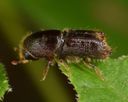Coarsewriting Engraver
Ips calligraphus
Classification
- Phylum: Arthropoda
- Subphylum: Hexapoda
- Class: Insecta
- Order: Coleoptera
- Suborder: Polyphaga
- Superfamily: Curculionoidea
- Family: Curculionidae
- Subfamily: Scolytinae
- Tribe: Ipini
- Genus: Ips
- Species: calligraphus
Pronunciation
How to pronounce Ips calligraphus: //ɪps kæˈlɪɡrəfəs//
These audio files are automatically generated. While they are not always 100% accurate, they are a good starting point.
Images




Summary
Ips calligraphus, or the coarsewriting engraver, is a bark beetle known for its etchings on tree bark and economic impact on timber industries in North America.
Physical Characteristics
Small beetle with characteristic coarse writing patterns on the surface of the bark they inhabit.
Identification Tips
Look for the distinctive six spines on the elytra.
Habitat
Found in forests, particularly in infested or dying trees.
Distribution
Found across North America, particularly common in Northeastern regions.
Diet
Feeds primarily on the cambium layer of conifer trees.
Life Cycle
The life cycle may be completed in 25 days in warmer climates.
Reproduction
May produce 6 or more generations per year depending on environmental conditions.
Ecosystem Role
Acts as both a decomposer and pest; facilitates the breakdown of dead trees.
Economic Impact
Can have significant impacts on forestry due to tree infestation and subsequent mortality.
Collecting Methods
- Trapping using pheromone lures
- Visual inspection of infested trees
Preservation Methods
- Preservation in alcohol
- Pinned collection for taxonomic study
Similar Taxa
Misconceptions
Often mistaken for other bark beetles; not all bark beetles are pests.
Tags
- Ips calligraphus
- Coarsewriting engraver
- Bark beetle
- Curculionidae
- Scolytinae